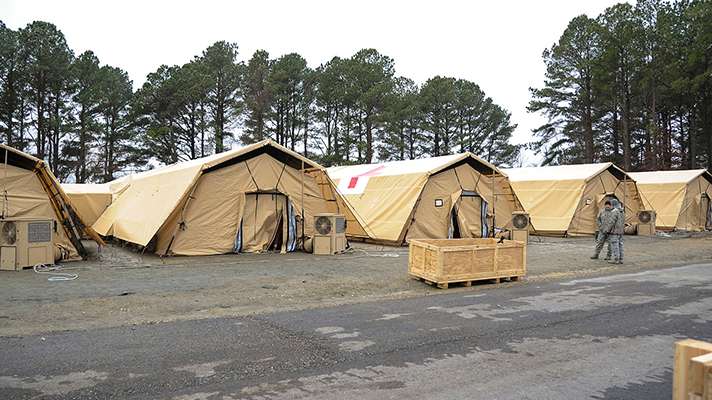Technology lessons learned for temporary hospital deployments

There is never good news when pandemics spread. As we move to deploy remote and IT-driven medical-care infrastructures, note that many American institutions (government, military and private sector) have already demonstrated extraordinary proficiency in these areas. We’ve done this before. We can do it now.
Make no mistake, the infrastructure needed to deliver world-class medical care is challenging to develop from scratch. Whether in a pop-up field hospital or a repurposed existing building, the demands are wide-ranging. These challenges run from setting up physical security, clean electric power and internet access, to deploying IT solutions secure enough to protect privacy and provide the analytics required by epidemiologists.
But this is nothing new for our nation. The U.S. military regularly sets up field hospitals in a matter of hours or days. These remote facilities have sterile surgical lab services that offer first-world care to our war fighters. I’ve seen far-away patches of dirt quickly become bustling centers equipped with the impressive services found back home.
Beyond the military, construction companies often set up remote operations with turnkey packages for housing, power, internet, security and medical care. The same is true for utility companies responding to disasters, or NGOs delivering humanitarian assistance. Frankly, our American expertise is unrivaled.
Our nation’s disaster experts are specialists, working their areas with a “spotlight focus” to deliver full-spectrum medical care. Since IT is so central to care delivery – either in-person, remote or outpatient – let’s leave the physical infrastructure to the experts for now and focus on the remote IT solutions and data collection needed in a time of a pandemic.
Lessons Learned
My experience in these situations has been instructive. I am a retired USAF Colonel and Healthcare Administrator with more than 24 years of experience running healthcare facilities around the globe. I have deployed five times to set up temporary healthcare facilities (Expeditionary Medical Support Hospitals) in remote locations, mostly in the Middle East. Here are some lessons learned by me and my team.
Keeping it Simple. Keep IT simple. IT is provisional in nature. When the pandemic passes, and it will eventually pass, the facility will be dismantled, and the temporary IT infrastructure will be absorbed into a permanent framework. There’s not always a need for on-site costly servers when cloud solutions are available through internet connectivity. If bureaucracy is involved in facility design – and it will be – leadership should resist complicated, multi-layered IT solutions.
Technology Integration. Don’t engage in ad hoc systems integration. This is no time for freelancing. Seek out an experienced technology-solutions provider to deliver custom solutions that extend enterprise IT capabilities to remote users. The partner must have enterprise-class, remote-delivery experience, ideally with federal, state, or local government agencies, or the DoD. It will configure solutions to spec and deploy integrated storage, compute, network, unified communications, wireless and security technology.
Sometimes that requires a ruggedized container; sometimes it’s just deployed over the internet. These solutions enable secure collaboration and communications, no matter where field workers are located, putting enterprise IT functionality at their fingertips.
Clean Power. Uninterruptible power sources with backup are key in the field. Today’s IT is very refined, but it still runs on old-fashioned AC power, which must come from a clean source. Don’t overlook this, as unglamorous as it may seem.
Physical Security. Establish a physical-security plan. Adhere to it with military discipline. In a pandemic, when panic is possible, or disruptors want to sow chaos, protect the facility and IT assets. Security solutions can range from a simple lockable facility up to web-based cameras, video surveillance and AI-driven visitor analytics.
Prepare for BOYD. In all emergencies, workers will bring their own devices including all phone types, Apple devices and PCs, tablets, wireless lab and medical equipment, and BI and analytical tools required by the government. All must be accommodated, but that’s easy to do with browser-based access solutions.
Desktop-as-a-Service. Workers will be remote, yet still need access to the applications, data and file storage of their regular enterprise systems. So, strongly consider Desktop-as-a-Service. DaaS solutions can be set up within hours, allowing workers anywhere to leverage a secure cloud platform (allowing HIPAA compliance) that delivers applications and desktops to any device with a browser. With DaaS, employees can use their personal devices without security concerns or complicated software.
Collect Just What’s Needed. For electronic health records, collect only pertinent patient data for dissemination to authorities or to allied healthcare facilities, e.g. a patient’s current condition, disease trajectory, whom they contacted when contagious and a notification protocol for those contacts. (These guidelines should be set by the commanding agency, such as the CDC.) Keep in mind that these pandemic operations are essentially a triage and not meant to deliver a full range of medical care.
Clear Understanding. Finally, keep all crisis information simple, clear, concise and focused. Consider Microsoft Teams as a solution to set up “channels” and conversations that are focused on specific tasks of conversation themes. Microsoft Teams can be invaluable for keeping appropriate information in the hands of the right people in a focused, disciplined manner, while allowing access to a wide range of communication and file-sharing tools.
In the meantime, keep safe by following CDC hygiene protocols. Take care of one another. We will soon look back at this time and be thankful we got through it with such professionalism, fortitude and human decency.
Jason Hall is retired USAF Colonel and Healthcare Administrator, with more than 24 years of experience running healthcare facilities around the world. He currently is a DoD Client Executive for Red River.


